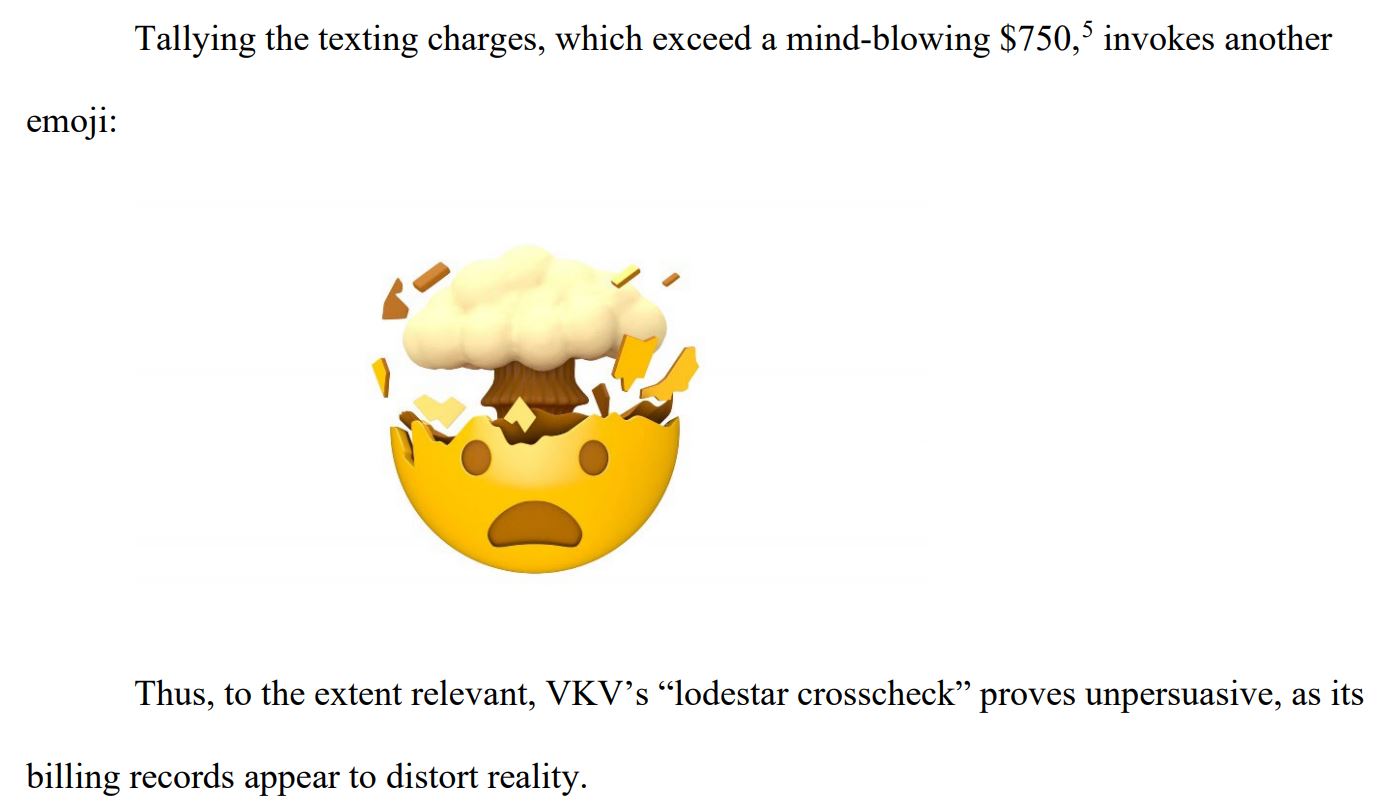Judge Rejects a Motion With the “Exploding Head” Emoji–DePietro v. Levitt
This is a class-action employment lawsuit. The parties settled and sought judicial approval of the settlement terms and associated attorneys’ fees. They didn’t get the approval. The judge balks at several terms of the settlement, including the attorneys’ fee request.
The judge really gets revved up talking about the lodestar comparison of the billable hours-based accumulations compared to the requested contingency fee. The judge implies that the plaintiffs’ lawyer inflated the billable hours:
On no less than five occasions, the assigned associate billed the client for sending a single text message. Each of these instances is charged at “0.17 hours” or ten minutes, which is, presumably, the smallest unit of measure in the firm’s recordkeeping system. Thus, each time the associate texted the client or opposing counsel, VKV added $51 to its bill. While it is possible that one could perseverate over a text for ten minutes, carefully wordsmithing the message, there is evidence here that undercuts such a proposition, as some of that text messaging was supplied to the Court.
When the associate wrote, for example, “okay, thanks. I’ll let you know,” or “confirmed at 35%,” it is difficult to imagine that such a composition consumed ten minutes. Even reading the client’s responses, which in one case consisted solely of an emoji indicating affirmation, cannot reasonably be seen as consuming much time. Given that both common experience as well as government studies suggest that a text can be sent or read in as little as a few seconds, charging a client ten minutes for each text sent would appear result [sic] in flagrant overcharging.
[Note 1: I’m open to any non-sex-related job where I can get paid $51 per text message. Then again, Bill Gates promised me $245 for a single forwarded email, and that was a quarter-century ago.]
[Note 2: “rounding up” is a well-known phenomenon among professionals who charge for their time by the hour. It’s one of the many inherent fictions in time-based billing. See, e.g., Patrick Schiltz’s classic article, where he told well-meaning new lawyers that eventually, due to billable hour time-padding, “you will be stealing from your clients almost every day, and you won’t even notice it.” The opinion doesn’t mention if the clients consented to a 10-minute minimum charge every time the lawyer touches the file, which clients are free to agree to…but judges can also reject that deal term when computing lodestar amounts.]
The judge already expressed strong condemnation by calling the plaintiff lawyers’ billable hour computations “flagrant overcharging,” but he didn’t stop there:
To be fair, lawyers routinely “distort reality” in their judicial filings. That’s literally what they are paid to do. But apparently these lawyers pushed their reality distortion too far for this judge.
* * *
This is a rare example of a judge using an emoji to express part of the opinion’s narrative, rather than referring to emojis contained in the litigants’ evidence. I hesitate to declare this the first time a U.S. judge has used an emoji to articulate their legal conclusion, but I can’t think of another example. The closest I can think of is when the 9th Circuit displayed the thumbs-up and heart emojis, instead of characterizing them textually, to refer to social media reactions. See Garnier v. O’Connor-Ratcliff. That was a pure word substitution. Here, the judge went further and actually integrated an emoji in his judicial “analysis.” That may have broken some new judicial ground.
While I enjoyed the emoji usage in this case, emojis aren’t always a great choice for judicial opinions. Emojis have slang meanings that judges won’t always know (such as the crown emoji having a special meaning in the sex trafficking community), plus those slang meanings can change over time in a way that may make this opinion inscrutable to future readers. That’s especially true with metaphor emojis (like an exploding head) because the associated metaphor’s meaning may evolve rapidly. Furthermore, a violence-based metaphor, like an exploding head, could be triggering to a small subset of readers who may have some first- or second-hand connection to the violence (Pulp Fiction came to mind for me [trigger-warning, literally], but head explosions are a trope especially in horror films). So judges should definitely use emojis advisedly.
* * *
For picking a powerful visual metaphor to express his disdain, I award the 🏆 emoji to Judge Gary R. Brown. (I’m also 🤯 that he’s a magician in addition to a judge).
Case Citation: DePietro v. Levitt LLP, 2023 U.S. Dist. LEXIS 231867 (E.D.N.Y. Dec. 14, 2023)

